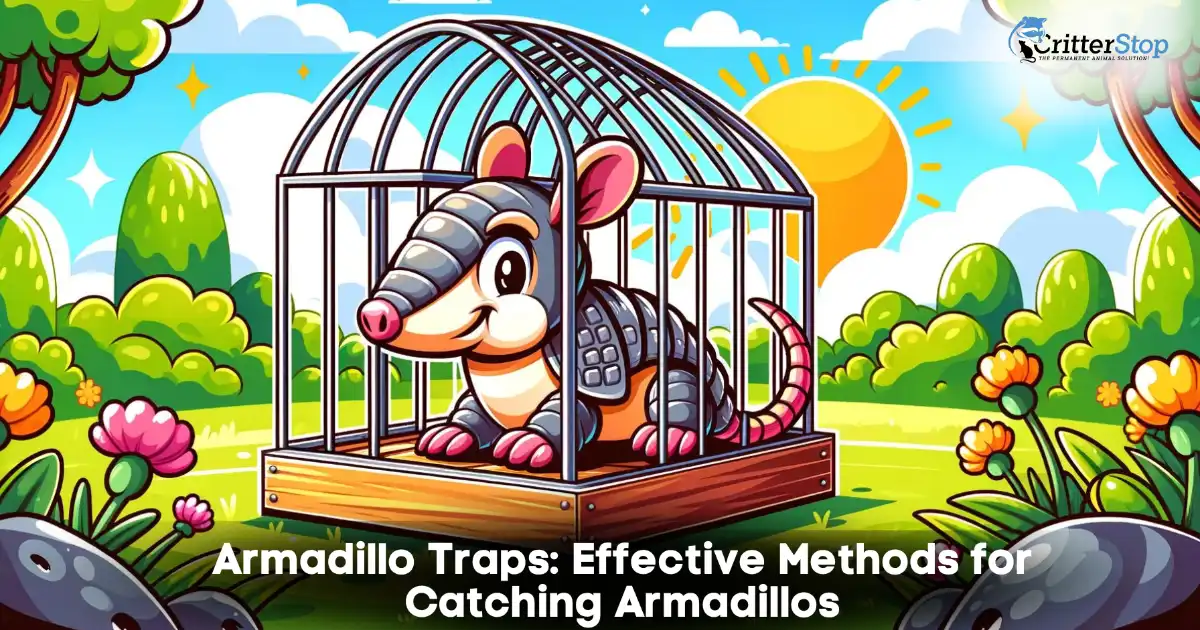
Armadillo traps are devices used to capture and remove armadillos from areas where they are causing damage. Armadillos are known for their destructive habits, including digging up lawns and gardens in search of insects and other food sources. They can also damage crops, golf courses, and other outdoor areas.
There are many different types of armadillo traps available, including live traps, lethal traps, and exclusion devices. Live traps are designed to capture armadillos alive so that they can be relocated to a different area. Lethal traps are designed to kill armadillos, often through the use of poison or other means. Exclusion devices are designed to keep armadillos out of specific areas, such as flower beds or gardens. However, the most effective way to deal with an armadillo invasion is to hire a wildlife removal professional.
Armadillos are small, burrowing mammals that are native to the Americas. They have a distinctive armored shell that protects them from predators. Armadillos tend to dig and burrow, abilities that they use to find food and shelter.
Armadillos are most active at night, which means they are nocturnal animals. They have poor eyesight but a keen sense of smell, with which they find their prey. Armadillos eat both plants and animals, which means they are omnivores. They primarily feed on insects, such as ants and termites, but they also eat small animals and plants.
Armadillos do not form social groups; they are solitary animals. They are territorial and will protect their dens from other armadillos. Armadillos are also known for their ability to roll into a ball when threatened, which makes it difficult for predators to attack them.
The habitats that armadillos inhabit are many and they include forests, grasslands, and deserts. They prefer areas with loose soil, which makes it easier for them to dig and burrow. Armadillos are also known to inhabit areas near water sources, such as rivers and streams.
Armadillos are opportunistic feeders and will eat whatever food is available to them. As they search for insects to eat, they are known to harm lawns and gardens. Additionally, armadillos are carriers of leprosy, which humans can contract by coming into contact with their excrement.
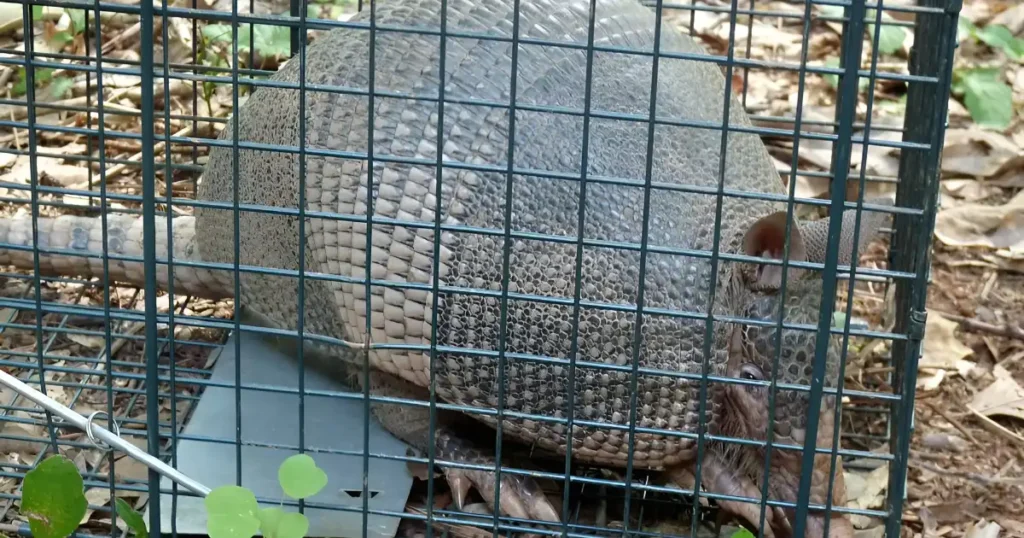
Armadillo trapping is a common method used to control armadillo populations. Traps are typically placed near armadillo burrows. Once trapped, armadillos can be relocated to a more suitable habitat.
Keep in mind that armadillo trapping is illegal in some states, though Texas isn’t one of them, and trapping this animal may require a permit. It is also important to use humane trapping methods and to release armadillos in a safe and appropriate location. Wildlife removal professionals possess the knowledge and expertise to not only trap and relocate armadillos successfully, but also ensure that they won’t find their way into your property again.
Armadillos can be quite a nuisance when they start digging up your lawn or garden. Fortunately, several types of armadillo traps can help you catch these creatures and relocate them to a more suitable location. Here are three types of armadillo traps that you can consider:
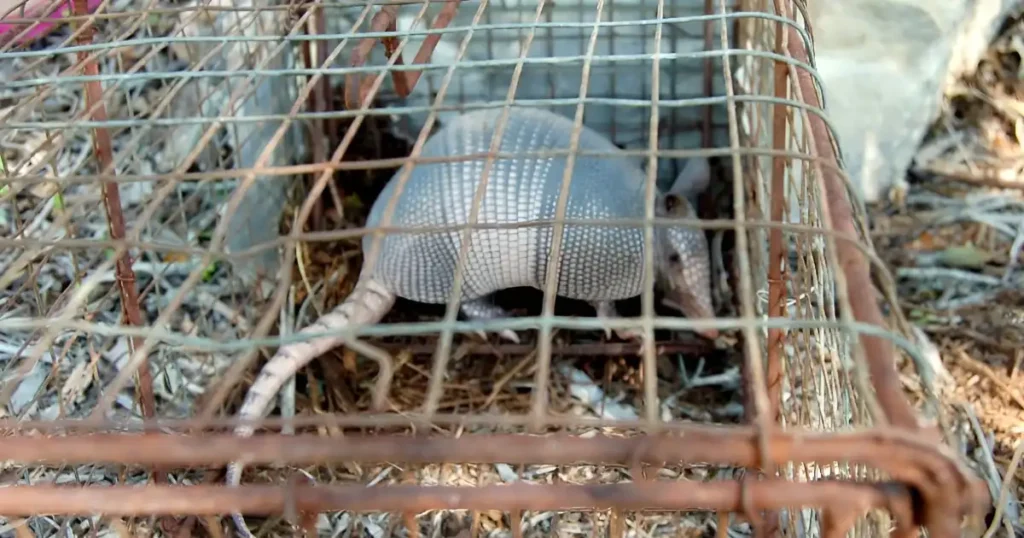
Cage traps are one of the most popular types of armadillo traps. Usually, they are made of wire mesh and have a door that closes once the armadillo enters the trap. These traps are easy to use and can be quite good when placed in areas where armadillos are known to frequent.
Wooden armadillo traps are another option that you can consider. These traps are typically made of wood and have a door that closes once the armadillo enters the trap. They are often more durable than cage traps and can be used for many years with proper maintenance.
If you are skilled at handling tools, you can also consider building your own armadillo trap. DIY armadillo traps can be made from a variety of materials, including wood, wire mesh, and PVC pipe. These traps can be customized to fit your specific needs and can be an affordable option for those on a budget.
When choosing an armadillo trap, it is important to consider the size of the trap, the durability of the materials used, and the ease of use. It is also important to check your local laws and regulations to ensure that you are using the trap legally and humanely.
Overall, armadillo traps can be a good way to catch and relocate this animal. By choosing the right type of trap and using it properly, you can help protect your lawn and garden from armadillo damage. However, setting traps yourself, especially homemade traps, may not be entirely effective. Instead, many homeowners recommend hiring a professional wildlife removal company to effectively remove armadillos in a manner that is friendly for both family and pets.
When it comes to trapping armadillos, using armadillo cage bait techniques may not work, as they may attract other animals, such as raccoons, before attracting armadillos. Trapping armadillo bait is not as effective as relying on the armadillo’s poor sight to lure it into a trap by placing wooden boards that will guide the armadillo. In conclusion, when setting a trap to catch an armadillo, using bait is not a proven method to attract them.
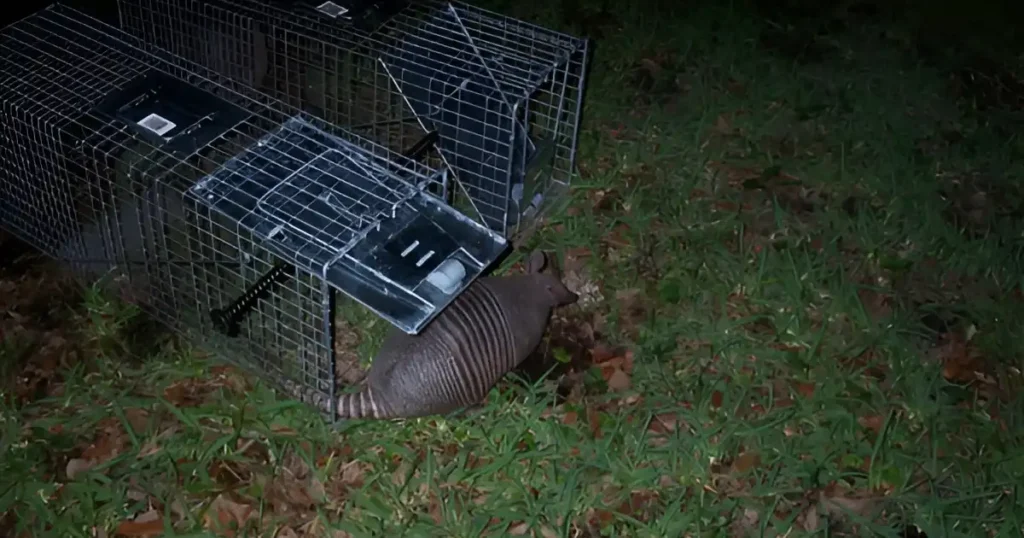
When it comes to trapping armadillos, setting and placing traps in the right location is crucial. Here is some advice on the ways to set and place traps to catch armadillos.
The first step in setting a trap is to choose the best trap for armadillo trapping. A live trap for an armadillo is the most humane option, as it allows you to catch the animal without harming it. Once you have the right trap, you need to place it in the correct location.
Armadillos are a nocturnal animal, so it's best to set the trap at night for the best results. Look for areas where armadillos are probably going to be active, including beside their burrows or on their usual routes. Position the trap in a shadowy area to prevent the armadillo from overheating.
It's important to ensure that the trap is set up safely to prevent any harm to the animal or humans. Always wear gloves when handling the trap to prevent any unwanted scent from transferring to the trap. Make sure that the trap is securely placed on an even surface to prevent it from falling over.
Once the armadillo is caught, it's important to release it safely and humanely. Select a spot that is distant from residential areas and highways. Release the armadillo in an area with plenty of cover, such as a wooded area or near a water source.
In conclusion, setting and placing traps for armadillos requires careful consideration of the trap and location. By following these tips, you may be able to catch this animal. However, if you want an effective and humane solution, your best bet is to hire a professional wildlife removal company.
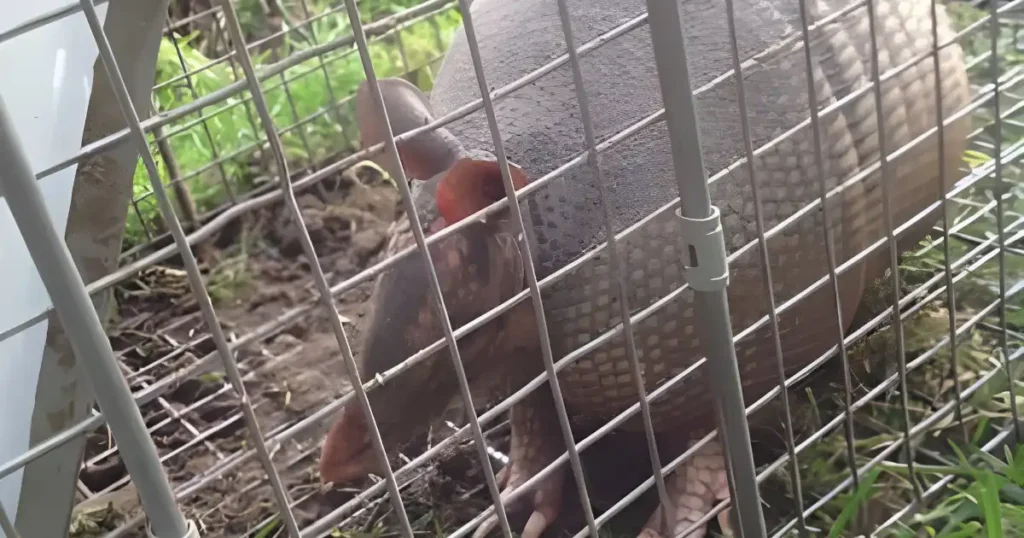
To create a homemade armadillo trap, you will need a few materials and tools. The following is a list of the items you will need:
After gathering all the required materials and tools, you can start building your armadillo trap. Follow these steps:
Remember to check the trap regularly and release any trapped armadillos back into the wild.
By following these steps, you can create your own wooden armadillo trap using free armadillo trap plans. With a little waiting and diligence, you may catch an armadillo and relocate it to a more suitable area. However, homemade traps may not be effective, and many homeowners opt for hiring a wildlife removal professional to deal with their armadillo invasions as they have the knowledge and expertise to effectively trap armadillos.
Are armadillos bothering you on your property? At Critter Stop, we have an expert team ready to get those creatures out of there for good. We service commercial and residential customers in Texas, offer industry-leading guarantees, and have a five-star reputation in humane professional wildlife removal. Contact Us today at (214) 234-2616 and book your free inspection and estimate today!
Bait is not very effective when it comes to trapping armadillos, as it will lure other animals like raccoons into the trap instead. A better way to trap armadillos is to rely on their poor sight and guide them into the trap using wooden boards.
There are several ways to construct a homemade trap for armadillos. The most widely used technique is to utilize a sizable lidded plastic storage container. The trap door will close as soon as the armadillo gets inside the container, locking it inside. Another option is to construct a wooden trap using plans or instructions found online. However, homemade traps may not be very effective.
After successfully trapping an armadillo, it is important to handle it carefully and humanely. Wear gloves and use a towel or blanket to cover the armadillo to reduce stress. Release the armadillo in a suitable habitat away from human populations. If relocation is not possible, contact a wildlife rehabilitation center or a wildlife removal professional for assistance.
Armadillos are nocturnal animals and are most active at night. They are also more active during warm and humid weather conditions. Therefore, the best time to set a trap is during the evening or early morning hours when armadillos are most active.
To humanely trap armadillos, it is important to use a trap that is appropriately sized and designed for the species. Check the trap frequently to ensure that the armadillo is not left confined for an extended time. Handle the armadillo carefully and release it in a suitable habitat as soon as possible. If you are unsure of how to humanely trap and release an armadillo, contact a professional wildlife removal company.
Plans and instructions for building a wooden armadillo trap can be found online or at a local hardware store. It is important to follow the instructions carefully and ensure that the trap is appropriately sized and designed for the species.
Visit our Critter Library and learn more about our furry friends